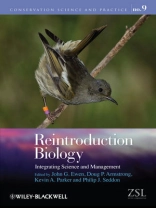This book aims to further advance the field of reintroduction biology beyond the considerable progress made since the formation of the IUCN/SSC Re-introduction Specialist Group. Using an issue-based framework that purposely avoids a structure based on case studies the book’s central theme is advocating a strategic approach to reintroduction where all actions are guided by explicit theoretical frameworks based on clearly defined objectives. Issues covered include husbandry and intensive management, monitoring, and genetic and health management. Although taxonomically neutral there is a recognised dominance of bird and mammal studies that reflects the published research in this field. The structure and content are designed for use by people wanting to bridge the research-management gap, such as conservation managers wanting to expand their thinking about reintroduction-related decisions, or researchers who seek to make useful applied contributions to reintroduction.
Table of Content
Contributors vii
Memorium of Don Merton xi
Foreword xix
Preface xxiii
1. Animal Translocations: What Are They and Why Do We Do Them? 1
Philip J. Seddon, W. Maartin Strauss and John Innes
2. A Tale of Two Islands: The Rescue and Recovery of Endemic Birds in New Zealand and Mauritius 33
Carl G. Jones and Don V. Merton
3. Selecting Suitable Habitats for Reintroductions: Variation, Change and the Role of Species Distribution Modelling 73
Patrick E. Osborne and Philip J. Seddon
4. The Theory and Practice of Catching, Holding, Moving and Releasing Animals 105
Kevin A. Parker, Molly J. Dickens, Rohan H. Clarke and Tim G. Lovegrove
5. Dispersal and Habitat Selection: Behavioural and Spatial Constraints for Animal Translocations 138
Pascaline Le Gouar, Jean-Baptiste Mihoub and François Sarrazin
6. Modelling Reintroduced Populations: The State of the Art and Future Directions 165
Doug P. Armstrong and Michelle H. Reynolds
7. Monitoring for Reintroductions 223
James D. Nichols and Doug P. Armstrong
8. Adaptive Management of Reintroduction 256
Michael A. Mc Carthy, Doug P. Armstrong and Michael C. Runge
9. Empirical Consideration of Parasites and Health in Reintroduction 290
John G. Ewen, Karina Acevedo-Whitehouse, Maurice R. Alley, Claudia Carraro, Anthony W. Sainsbury, Kirsty Swinnerton and Rosie Woodroffe
10. Methods of Disease Risk Analysis for Reintroduction Programmes 336
Anthony W. Sainsbury, Doug P. Armstrong and John G. Ewen
11. The Genetics of Reintroductions: Inbreeding and Genetic Drift 360
Lukas F. Keller, Iris Biebach, Steven R. Ewing and Paquita E.A. Hoeck
12. Genetic Consequences of Reintroductions and Insights from Population History 395
Jim J. Groombridge, Claire Raisin, Rachel Bristol and David S. Richardson
13. Managing Genetic Issues in Reintroduction Biology 441
Ian G. Jamieson and Robert C. Lacy
14. Summary 476
Philip J. Seddon, Doug P. Armstrong, Kevin A. Parker and John G. Ewen
Index 483
About the author
John Ewen is a Research Fellow at the Institute of Zoology,
Zoological Society of London and is supported by a Research
Councils UK Academic Fellowship. He is currently co-leader of the
New Zealand Department of Conservation’s Hihi Recovery Group and is
a member of the IUCN/SSC Reintroduction Specialist Group.
Doug Armstrong is the Professor of Conservation Biology
at Massey University in New Zealand. He has been involved in
reintroduction since 1992, and has been the Oceania Chair of the
IUCN/SSC Reintroduction Specialist Group since 1997.
Kevin Parker is a post-doctoral fellow at Massey
University, New Zealand. He is a member of the IUCN/SSC
Reintroduction Specialist Group.
Phil Seddon is an Associate Professor at the University
of Otago and Director of the Department of Zoology’s Postgraduate
Wildlife Management Programme. Phil has been a member of the
IUCN/SSC Re-introduction Specialist Group (RSG) since 1995, and RSG
Bird Section Chair since 1998.












